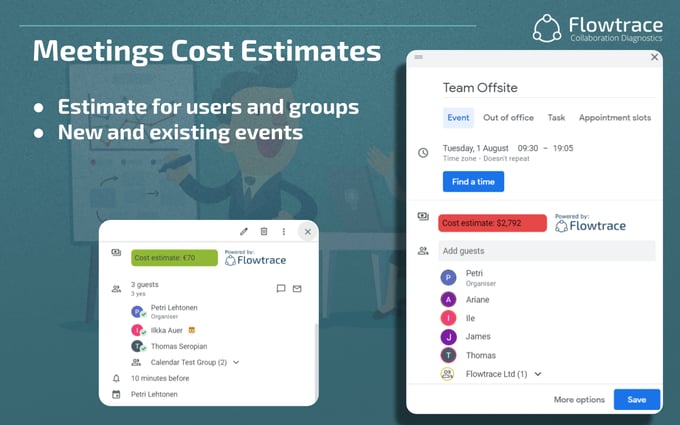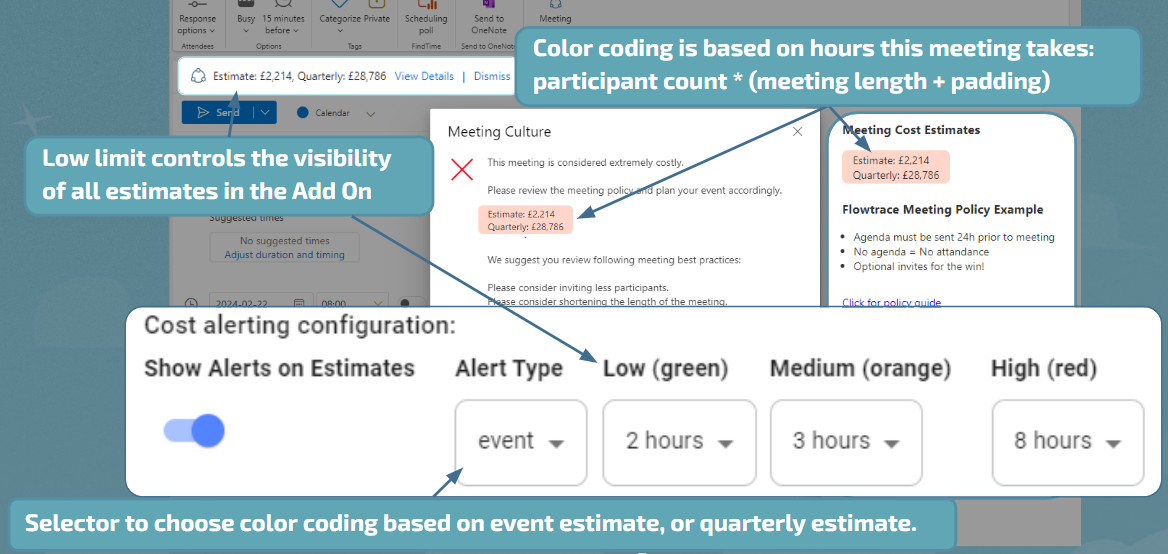Cost-Saving Strategies for Meetings
Explore cost-saving strategies for meetings, including conducting calendar audits, understanding meeting culture, implementing meeting analytics...
Understanding and managing company meeting costs is essential for organizational efficiency and financial health. Explore the impact of direct, indirect, and hidden expenses on productivity and employee satisfaction.
Understanding company meeting costs is crucial for any organizational leader striving for efficiency and financial judgment. Meetings, often seen as the heart of corporate communication and decision-making, come with a cost – one that extends beyond the obvious expenses. These costs, if not managed wisely, can significantly impact an organization's financial health and employee productivity.
In this article, we will look into the various aspects of company meeting costs, exploring not only the direct expenditures but also the indirect and often hidden costs that are incurred. For leaders, the ability to comprehend and manage these costs effectively is vital for creating a productive, efficient, and financially sound organizational environment.
Understanding company meeting costs requires splitting them into three primary categories: direct, indirect, and hidden expenses. Each type plays a critical role in the overall financial impact of meetings on an organization.
65% of managers say that meetings keep them from completing their work

These are the expenses directly incurred from organizing a meeting. In the context of in-person meetings, direct costs can include logistics like travel for attendees, room rentals, catering services, and rental fees for venues. There's also the cost of materials, such as printing handouts and presentation slides, along with supplies like pens and notepads.
These costs are not immediately visible but significantly impact an organization. They include employee downtime and lost productivity while away from regular duties. When planning an in-person meeting, factors like the hourly cost or any overtime hours should also be considered. There may be regulatory costs associated with certain types of business activities conducted during an event.
The hidden costs of meetings are often the most challenging to quantify but are critical to understanding company meeting costs. They can include intangibles like the impact on employee morale or the opportunity cost of time that could have been spent on other productive activities.
An alarming statistic from Prevue Meetings & Incentives illustrates the rising financial burden of meetings: the cost per attendee for in-person meetings and events has increased by about 25% compared to 2019, with a further predicted increase of 7% in 2023. This underlines the importance of not only recognizing but also actively managing these varied meeting costs to ensure financial sustainability and operational efficiency.
Understanding company meeting costs is more than just an analysis of expenditure, it's about recognizing their broad impact on an organization's overall health. These costs significantly influence three key areas: productivity, employee satisfaction, and financial health.
Productivity: Meetings, especially when poorly managed or unnecessary, can lead to substantial productivity losses. Employees often find themselves engaged in meetings that may not require their presence, detracting from time that could be spent on productive tasks.

Employee Satisfaction: The frequency of meetings and their nature can also affect employee morale and engagement. Excessive or ineffective meetings can lead to frustration and a sense of wasted time, which, in turn, impacts overall job satisfaction and engagement levels.

Financial Health: The financial implications of meetings are profound. According to McKinsey, employee disengagement and attrition, which can be exacerbated by poor meeting management, could cost a median-size S&P 500 company between $228 million and $355 million a year in lost productivity. Over five years, this amounts to at least $1.1 billion in lost value per company.
Understanding company meeting costs involves acknowledging their multifaceted impact on an organization. It's not just the direct expenses that matter, but also the indirect effects on productivity, employee morale, and the organization's financial well-being.
Effectively measuring and analyzing meeting costs is critical when it comes to managing them efficiently. Various methods and tools are available to assist in this process.
Manual Tracking and Analysis: This involves keeping records of all meeting-related expenses, including time spent in preparation, execution, and follow-up. While this method can be time-consuming, it provides a detailed insight into the costs incurred.
Time Tracking Software: Tools like time tracking software can help quantify the amount of time employees spend in meetings, which can then be translated into cost using average hourly wage rates.
Meeting Cost Calculators: There are online calculators specifically designed to estimate the cost of meetings based on factors like duration, frequency, and the number of participants. Flowtrace has meeting cost calculators for both Microsoft Outlook and Google Calendar.

Integrated Software Solutions: Solutions like Flowtrace offer a more comprehensive approach. They not only track meeting data but also provide analytics on the effectiveness of these meetings. Flowtrace can identify patterns, such as frequent unnecessary meetings or meetings with too many participants, helping leaders make informed decisions about optimizing meeting practices.
These tools and methods collectively enable organizations to gain a clearer picture of their meeting costs. By quantifying these costs and understanding their impact, leaders can make strategic changes to improve efficiency and reduce unnecessary expenditures.
Efficient meeting management is essential to optimize expenses and enhance productivity. Here are some best practices:
Clear Agenda Planning: Set a clear, concise agenda for each meeting. This helps in keeping discussions focused and time-bound, reducing the likelihood of overruns that can escalate costs.
Strict Time Management: Adhere to a strict time schedule for meetings. Starting and ending on time respects participants' schedules and curtails unnecessary time expenditure.
Selective Participation: Ensure only key stakeholders are in attendance. This minimizes the indirect costs associated with pulling numerous employees away from their core tasks.
Leverage Technology: Utilize meeting and collaboration tools to conduct meetings more efficiently. Tools like Flowtrace can provide insights into meeting patterns, helping identify areas for improvement.
Regular Review of Meeting Practices: Periodically review meeting practices and solicit feedback from participants. This helps in identifying inefficiencies and areas for cost reduction.
Promote Virtual Meetings: When possible, opt for virtual meetings to cut down on travel and logistical expenses.
By focusing on these strategies, you can significantly enhance the efficiency and effectiveness of meetings, leading to optimized expenses and improved overall productivity.
Understanding the financial impact of company meetings is crucial for optimizing operational efficiency and reducing unnecessary expenses. Meetings, while essential for collaboration and decision-making, can quickly become a significant cost center if not managed properly. To effectively cut meeting costs, organizations need to adopt a strategic approach.
Assess Meeting Necessity: Regularly evaluate the need for recurring meetings. Eliminate or reduce the frequency of those that do not contribute substantial value or can be replaced with more efficient communication methods.
Utilize Meeting Cost Calculators: Implement tools like Flowtrace’s meeting cost calculator for Google Calendar and Microsoft Outlook. These tools provide real-time insights into the financial impact of meetings by analyzing factors such as duration and participant count, helping identify cost-saving opportunities.

Adopt Virtual Meetings: Whenever possible, replace in-person meetings with virtual ones to cut down on travel and venue costs. Virtual meetings can also help reduce the indirect costs associated with time spent commuting.
Optimize Meeting Duration and Frequency: Use data from meeting analytics to adjust the length and frequency of meetings. Ensure that each meeting has a clear purpose and agenda to avoid unnecessary extensions.

Encourage Efficient Meeting Practices: Promote practices such as starting and ending meetings on time, sticking to the agenda, and involving only necessary participants. This helps in minimizing time wastage and ensuring that meetings are productive.
By implementing these strategies, businesses can significantly reduce their meeting-related expenses. Cutting unnecessary meetings not only saves money but also frees up valuable time for employees to focus on high-impact activities. This proactive approach to meeting management fosters a more productive and cost-efficient organizational culture, ultimately driving better business outcomes.
In remote and hybrid work environments, managing meeting costs presents unique challenges and opportunities. While these setups can reduce direct expenses such as travel and physical space requirements, they introduce new dimensions to cost management.
One of the key challenges is the potential increase in the frequency of meetings. Remote and hybrid settings often necessitate more regular check-ins to maintain team cohesion and workflow synchronization. This increase can inadvertently lead to a surge in indirect costs, such as time spent away from other productive activities. The ease of scheduling virtual meetings may also lead to a 'meeting culture' where the default response to any issue is to schedule a meeting.

To manage these challenges, organizations need to foster a culture where meetings are only scheduled when necessary, emphasizing asynchronous communication methods like emails or project management tools for routine updates. This approach can help in reducing the overload of virtual meetings, thereby minimizing indirect costs.
Another aspect is the effective use of technology. In remote and hybrid settings, leveraging the right tools for collaboration and communication is crucial. Tools that provide insights into meeting frequency, duration, and participant engagement can help identify and cut down on unnecessary meetings, thus managing costs more effectively.
Ultimately, the goal in remote and hybrid work environments should be to strike a balance between maintaining effective communication and collaboration while avoiding the pitfalls of excessive virtual meetings, thereby keeping meeting costs in check.
For strategic meeting cost management, data analytics is crucial. It plays a role in understanding and effectively managing the expenses associated with meetings. By analyzing data on meeting frequency, duration, participant numbers, and associated costs, organizations can gain critical insights into the direct and indirect expenses of their meetings.
This data-driven approach enables leaders to identify patterns of inefficiency, such as recurrent unnecessary meetings or excessively long discussions, and implement targeted strategies to address them. Leveraging data analytics transforms meeting cost management from a reactive to a proactive practice, ensuring meetings are both cost-effective and productive.
Understanding and managing company meeting costs is vital for maintaining organizational efficiency and financial health. Leaders must recognize the multifaceted nature of these costs and the significant impact they have on productivity and employee satisfaction.
Leveraging tools and strategies for effective cost management, such as data analytics and efficient meeting practices, is essential. By doing so, leaders can ensure that meetings are not just a cost center but a value-adding aspect of organizational operations, driving both productivity and innovation.
Explore cost-saving strategies for meetings, including conducting calendar audits, understanding meeting culture, implementing meeting analytics...
Calculate meeting costs with this interactive meeting cost calculator giving you an accurate representation of how much money your meetings are...
Improve efficiency, reduce costs, and make smarter decisions with a meeting cost calculator. Understand the financial implications and optimize...